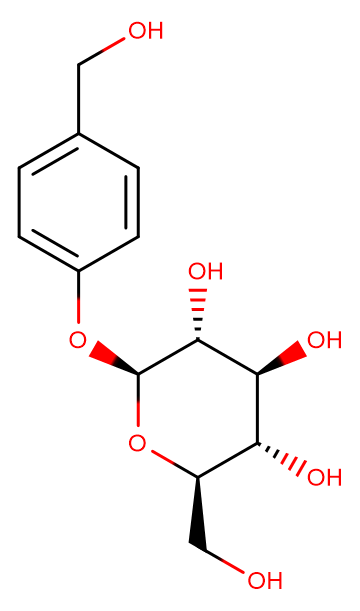
Gastrodin
CAS No. 62499-27-8
Gastrodin ( —— )
Catalog No. M15364 CAS No. 62499-27-8
Gastrodin, an anti-inflammatory polyphenol extracted from Chinese natural herbal Gastrodia elata Blume., benefits neurodegenerative diseases.
Purity : >98% (HPLC)
 COA
COA
 Datasheet
Datasheet
 HNMR
HNMR
 HPLC
HPLC
 MSDS
MSDS
 Handing Instructions
Handing Instructions
| Size | Price / USD | Stock | Quantity |
| 50MG | 45 | In Stock |


|
| 100MG | Get Quote | In Stock |


|
| 200MG | Get Quote | In Stock |


|
| 500MG | Get Quote | In Stock |


|
| 1G | Get Quote | In Stock |


|
Biological Information
-
Product NameGastrodin
-
NoteResearch use only, not for human use.
-
Brief DescriptionGastrodin, an anti-inflammatory polyphenol extracted from Chinese natural herbal Gastrodia elata Blume., benefits neurodegenerative diseases.
-
DescriptionGastrodin, an anti-inflammatory polyphenol extracted from Chinese natural herbal Gastrodia elata Blume., benefits neurodegenerative diseases. Extracted from Orchids Gastrodia; Suitability:Water,methanol,ethanol;Store the product in sealed,cool and dry condition.(In Vitro):Gastrodin treatment reduces the mRNA expression levels of TNF-α and iNOS in the retinas of acute ocular hypertension.(In Vivo):Intraperitoneal injection with Gastrodin 10 mg/kg or 50 mg/kg once daily for 15 d significantly inhibits the loss of retinal ganglion cells (RGCs) because of acute ocular hypertension (AOH) damage. 2 wk after AOH, the number of Iba1 positive retinal microglia obviously reduces to 231.3±54.3 cells/mm2 and 201.9±43.1 cells/mm2 in the rats intraperitoneally injected with Gastrodin at 10 mg/kg and 50 mg/kg, respectively.
-
In Vitro——
-
In Vivo——
-
Synonyms——
-
PathwayOthers
-
TargetOther Targets
-
RecptorOthers
-
Research AreaNeurological Disease
-
Indication——
Chemical Information
-
CAS Number62499-27-8
-
Formula Weight286.28
-
Molecular FormulaC13H18O7
-
Purity>98% (HPLC)
-
SolubilityDMSO: 50 mg/mL (174.65 mM)
-
SMILESC1=CC(=CC=C1CO)O[C@H]2[C@@H]([C@H]([C@@H]([C@H](O2)CO)O)O)O
-
Chemical Name——
Shipping & Storage Information
-
Storage(-20℃)
-
ShippingWith Ice Pack
-
Stability≥ 2 years
Reference



-
HLM006474
HLM006474 is a pan inhibitor of E2F. This inhibits E2F4 DNA-binding (IC50: 29.8 μM in A375 cells).HLM006474 causes the viability of both SCLC and NSCLC lines (IC50 ranging from 15 to 75 μM). HLM006474 displays little activities against E2F4 DNA-binding in A375 cells at 10 and 20 μM, apparently inhibits E2F4 DNA-binding at 40 μM, and increasingly suppresses the effect at 60 and 80 μM concentrations.
-
Ethylmalonic acid
Ethylmalonic acid can be found in blood cerebrospinal fluid (CSF) and urine as well as in human fibroblasts prostate and skeletal muscle tissues. Moreover ethylmalonic acid is found to be associated with anorexia nervosa and malonyl-CoA decarboxylase deficiency. Ethylmalonic acid is a non-carcinogenic potentially toxic compound.
-
6,7-dimethoxy-N-(4-n...
6,7-dimethoxy-N-(4-nitrophenyl)quinazoli



 Cart
Cart
 sales@molnova.com
sales@molnova.com


